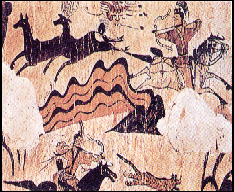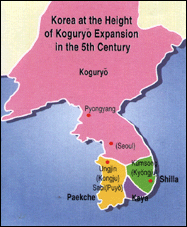KOREA>HISTORY>The Three Kingdoms
![]()
3. The Three Kingdoms
 Korea's earliest recorded history is characterized by clan communities that
combined to form small town-states. The town-states gradually united into
tribal leagues with increasingly complex political structures. This state of
affairs prevailed throughout the peninsula and southern Manchuria until
roughly the beginning of the Christian era.
Korea's earliest recorded history is characterized by clan communities that
combined to form small town-states. The town-states gradually united into
tribal leagues with increasingly complex political structures. This state of
affairs prevailed throughout the peninsula and southern Manchuria until
roughly the beginning of the Christian era. Among various tribal leagues, Koguryo (37 B.C.-A.D. 668), along the middle course of the Amnok River, was the first to mature into a kingdom. Its belligerent troops conquered neighboring tribes one after another. They finally drove the Chinese out of Nangnang in 313 A.D. and expanded their territory deep into Manchuria. These developments in the north had repercussions in the politically and culturally less advanced southern part of the peninsula. A group of refugees from Koguryo founded a new kingdom named Paekche (18 B.C.-A.D. 660) south of the Han River in the vicinity of present-day Seoul. The people of Paekche kept moving south to avoid the threats of their northern rival. By the fourth century, they completely dominated the southwestern part of the peninsula. Paekche was firmly established as a prosperous and civilized state, trading extensively with China across the sea.  Shilla
(57 B.C.-A.D. 935), which was geographically isolated from Chinese
influence, was at first the weakest and most underdeveloped of the three
kingdoms. The last to adopt foreign creeds and ideas, its society was
markedly class-oriented and developed remarkable power, drawing resources
from its unique Hwarang Corps and Buddhist teachings. Shilla
(57 B.C.-A.D. 935), which was geographically isolated from Chinese
influence, was at first the weakest and most underdeveloped of the three
kingdoms. The last to adopt foreign creeds and ideas, its society was
markedly class-oriented and developed remarkable power, drawing resources
from its unique Hwarang Corps and Buddhist teachings. Sandwiched between them for a while in the south was the loose confederacy of Kaya that conducted extensive coastal trade and also maintained close ties with the tribal states in western Japan. Kaya was absorbed by its neighbors during the sixth century. By the mid-sixth century, Shilla effected a military alliance with Tang China to subjugate both Koguryo and Paekche. But China was a dangerous ally. Shilla had to take up arms against China when the Chinese exposed their own ambition to incorporate the territories of Koguryo and Paekche into their own empire. Although politically separate, the three kingdoms of Koguryo, Paekche and Shilla were related ethnically and linguistically. Each of them developed a sophisticated political structure and legal system and adopted Confucian ethics and Buddhist faith. Buddhism spread rapidly among the upper classes of these kingdoms after it was introduced in the fourth century through China. Rulers of all three kingdoms patronized Buddhism and used it to bolster their power. Korean monks traveled to China and India to study the scriptures and transmitted Buddhist literature and arts to Japan, playing a decisive role in the development of that country's ancient civilization. |
